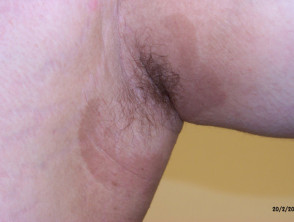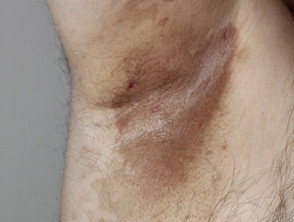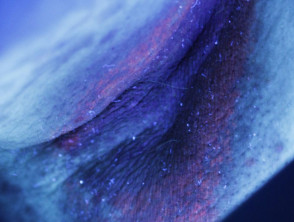What is erythrasma?
Erythrasma is a common skin condition affecting the skin folds under the arms, in the groin and between the toes.
Who gets erythrasma?
Erythrasma affects males and females, but it is thought to be more common in the groin of males and between the toes of females.
It is reported to be more prevalent in the following circumstances:
- Warm climate
- Excessive sweating
- Skin of colour
- Diabetes
- Obesity
- Poor hygiene
- Advanced age
- Other immunocompromised states.
What causes erythrasma?
The bacteria responsible for erythrasma are gram-positive, non-spore-forming, aerobic or facultative bacilli called Corynebacterium minutissimum.
Erythrasma may coexist with or be confused with other causes of intertrigo including fungal infections such as tinea or Candida albicans (thrush).
What are the clinical features of erythrasma?
Erythrasma presents as well-defined pink or brown patches with fine scaling and superficial fissures. Mild itching may be present.
The common sites for erythrasma are armpits, groin and between the toes. The intergluteal fold, submammary, and periumbilical skin may also be affected. Widespread infections are most often associated with diabetes mellitus.
Erythrasma is classified into three types according to location.
- Interdigital erythrasma: between the 3rd, 4th and 5th toe web spaces
- Intertriginous erythrasma: in the armpits, groin, under the breasts and umbilicus
- Generalised/disciform erythrasma: on the trunk
Erythrasma
See more images of erythrasma.
What are the complications of erythrasma?
Erythrasma is usually self-limiting. It can be complicated by contact dermatitis, lichenification, postinflammatory pigmentation, and coinfection with other bacteria, yeasts, and dermatophytes.
Serious complications are very rare. Corynebacteria have been reported to causes abscess, cellulitis, cutaneous granuloma, endocarditis, pyelonephritis, endophthalmitis, arteriovenous fistula infection and meningitis.
How is the diagnosis of erythrasma made?
Erythrasma has a typical clinical appearance. Diagnosis may be supported by the following investigations.
- Wood lamp skin examination: long wavelength ultraviolet radiation causes erythrasma to fluoresce a coral-pink colour due to coproporphyrin III released by the bacteria. The fluorescence is not seen if the skin has recently been washed because the responsible porphyrin is water soluble.
- Swab or skin scrapings: microscopy with periodic acid–Schiff, methenamine silver, or a Gram stain may reveal gram-positive filamentous rods. Methylene blue also stains C. minutissimum.
What is the treatment for erythrasma?
Erythrasma can be treated with antiseptic or topical antibiotic such as:
- Fusidic acid cream
- Clindamycin solution
- Benzoyl peroxide
- Whitfield ointment (3% salicylic acid, 6% benzoic acid in petrolatum).
Extensive infection can be treated with oral antibiotics, including erythromycin or tetracycline and usually responds promptly.
Photodynamic therapy using red light (broadband, peaking at 635 nm) has also been used to treat patients with erythrasma.
How is erythrasma prevented?
Recurrence of erythrasma is common. Antibacterial soap can be used to prevent recurrence. Treatment can be repeated if necessary.


